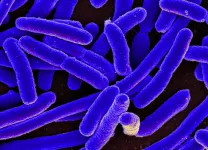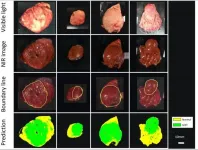A mouse study suggests the genetic contribution to anxiety is partially mediated by the gut microbiome
By Greta Lorge
The prevalence of anxiety disorders, already the most common mental illness in many countries, including the U.S., has surged during the novel coronavirus pandemic. A study led by researchers in Berkeley Lab's Biosciences Area provides evidence that taking care of our gut microbiome may help mitigate some of that anxiety.
The team used a genetically heterogeneous lineage of mice known as the Collaborative Cross (CC) to probe connections among genes, gut microbiome composition, and anxiety-like behavior. They first categorized 445 mice across 30 CC strains as high or low anxiety based on their behavior in the light/dark box assay: a box with two compartments - one transparent and illuminated, the other black and unilluminated - connected by an opening. The degree to which rodents' innate aversion to brightly lit, open spaces supersedes (or doesn't) their instinct to explore a novel environment is a rough analog for high (or low) anxiety.
The researchers then performed genome-wide association study (GWAS) analysis, comparing high and low anxiety mice, and also analyzed and compared gut microbiome composition in high versus low anxiety animals. They identified specific genetic variants and families of gut microbes associated with anxiety-like behavior, including host genes that influence anxiety indirectly by modulating the abundance of specific microorganisms in the gut.
"We hope this study will inform future research to evaluate treatments for anxiety that take into account both host genome and microbiome," said co-lead author Antoine Snijders, a staff scientist in the Biological Systems and Engineering Division.
The study was conducted in collaboration with Dr. Xiaoqing Jin, a visiting scholar from Zhongnan Hospital of Wuhan University.
A Detailed Look Inside Tsetse Flies
3D imaging at Berkeley Lab's Advanced Light Source provides new insights into reproductive biology of parasite-carrying flies
To better understand the unique reproductive biology of tsetse flies, which are carriers of the parasites that cause a deadly infection known as African sleeping sickness, researchers explored the intact organs and tissues of tsetse flies using a powerful 3D X-ray imaging technique at Berkeley Lab.
The imaging technique provided new insights into how the flies' specialized biology governs mating and reproductive processes, including female flies' unique lactation and their delivery of a single fully developed larvae per birthing cycle - whereas most other insect species lay eggs. The ALS produces X-rays and other forms of light for a broad range of simultaneous scientific experiments.
Fly samples were prepared at various stages of the reproductive cycle, and researchers are ultimately aiming to couple the imaging data with gene expression and biochemical data from the same stages of this cycle.
"We want to understand what changes are happening during this process, how the process is being mediated, and if it can be manipulated to artificially repress females in the wild from mating," said Geoffrey Attardo, an assistant professor of entomology and nematology at UC Davis - which would ideally curb disease transmission. In 2015, about 3,500 people died from African sleeping sickness, and about 11,000 people are now estimated to be infected. The infection is fatal if it is left untreated by medication.
Attardo led a study, published in the journal Insects, detailing the ALS imaging work. The ALS experiments yielded better results than expected, he said.
While some other techniques require dissection and staining processes that introduce damage to the delicate samples, "This project allowed us to create a detailed 3D visualization of the reproductive tissues in their native context, with minimal experimental manipulation," he said.
The ALS experiments provided a first, detailed look at the intact structure of a sperm-delivery structure called a spermatophore that fully occupies a female fly's uterus after mating, for example, and detailed imaging of other reproductive-tract tissues relevant to lactation and birth.
"I love that as a staff member at the ALS, I can help enable science that makes a difference in the world," said Dula Parkinson, an ALS staff scientist and Diffraction and Imaging Program leader who participated in the study.
Pioneering Framework Could Reduce Energy Demand in Buildings
Researchers make the case for shifting how we think about heating and cooling needs in buildings
By Kiran Julin
Heating and cooling buildings is a large part of global energy demand and a significant source of CO2 and greenhouse gas emissions, and in the coming decades the energy demand for heating and cooling - also known as thermal energy - is expected to grow considerably. Scientists and engineers have made many advances in lowering building energy demand by improving energy efficiency in building technologies and reducing energy loss through the building walls and windows.
Now, researchers are concerned that simply tackling the problem through energy-efficient technology and design will reach its practical limits. So researchers from Lawrence Berkeley National Laboratory (Berkeley Lab), the National Renewable Energy Laboratory, and UC Berkeley have pioneered a new framework that determines the minimum thermal energy required to keep building occupants comfortable.
In a study recently published in the journal Joule they make the case for calculating the theoretical minimum thermal load in order to dramatically lower the energy required for heating and cooling buildings.
"Our work shows that current thermal loads in buildings are more than an order-of-magnitude higher than the theoretical minimum thermal load," said Ravi Prasher Berkeley Lab's Associate Lab Director for Energy Technologies and the corresponding author of the paper. "In fact, the theoretical minimum thermal load showed that in residential buildings the energy used for heating or cooling an entire building for occupant comfort could be between 19 to 40 times lower."
The theoretical minimum thermal load does not calculate the amount of heating or cooling that would be needed to make an uncomfortable space comfortable, but rather it sets up a new baseline for occupant comfort with different building parameters. By calculating this baseline, the researchers are identifying the physical limit for reduced thermal energy use, that is, the point at which further reduction in thermal energy would cause occupant discomfort.
Read more
AI Finds More Than 1,200 Gravitational Lensing Candidates
Berkeley Lab researchers among participants in effort, which could double the number of known lenses
A research team with participation by Berkeley Lab physicists has used artificial intelligence to identify more than 1,200 possible gravitational lenses - objects that can be powerful markers for the distribution of dark matter. The count, if all of the candidates turn out to be lenses, would more than double the number of known gravitational lenses.
Gravitational lenses result from large celestial objects, like galaxies or galaxy clusters, that bend the path of light traveling from more distant galaxies. When these chance alignments are almost perfect, this creates false images that can include rings, partial rings, multiple images, and other illusions.
The lenses can tell us about the contribution of dark matter in those distant, lensed objects, as we can only witness dark matter through its gravitational effects on visible matter. And that could help unravel one of the biggest mysteries in the universe, as dark matter accounts for an estimated 85% of the total mass of the universe.
All of the candidate lenses - discovered using a form of artificial intelligence known as deep residual neural networks - are considered to be of the strong variety, meaning they exhibit highly visible lensing effects. A study detailing the new lensing candidates has been accepted for publication in The Astrophysical Journal, and a preprint is available at arXiv.org.
"I really thought it would be many years before anyone would find this many gravitational lenses," said David Schlegel, a senior physicist at Berkeley Lab who participated in this study. "It's just amazing to know that you're seeing, very clearly, space itself being warped by a massive object." Schlegel also participated in an earlier study that turned up 335 new strong lensing candidates.
Researchers used a sample of 632 observed lenses and lens candidates, and 21,000 non-lenses to train the deep neural networks used in the study. The sample set was obtained from two sky surveys: the Dark Energy Camera Legacy Survey (DECaLS) and Dark Energy Survey (DES). About 1 in 10,000 massive galaxies was expected to be a strong gravitational lensing candidate.
The DECaLS survey was one of three surveys that was conducted in preparation for the startup of the Dark Energy Spectroscopic Instrument (DESI), a Berkeley Lab-led experiment that will help us to better understand dark energy, which is driving the universe apart at an accelerating rate.
Researchers used computing resources at Berkeley Lab's National Energy Research Scientific Computer Center (NERSC) for their data analysis. NERSC is a DOE Office of Science user facility.
INFORMATION:
More
"Doubling the Number of Known Gravitational Lenses," NOIRLab, Jan. 13, 2021
"Seeing the Universe Through New Lenses," May 14, 2020





